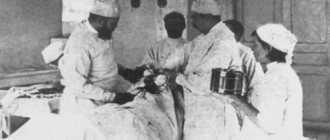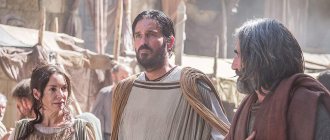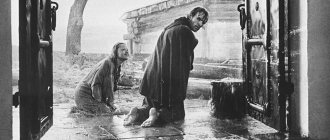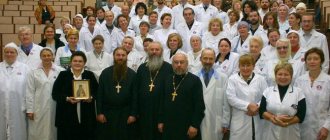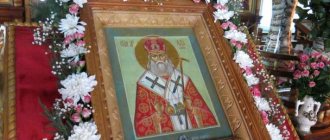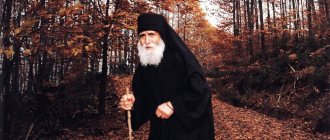Heal Fear
The genius of Valentin Feliksovich Voino-Yasenetsky as a surgeon amazed both patients and colleagues: eyewitnesses say that his hands, even when Archbishop Luke turned 60, were “unusually accurate, proportionate and virtuosic.” “The finest sense of touch, obviously, was innate in my father,” recalled son Mikhail. “Once, while talking with us, his children, on this topic, he decided to prove it to us “in practice.” He folded ten sheets of thin white paper, and then asked them to give tasks: with one stroke of a sharp (this was a prerequisite!) scalpel, cut any number of sheets. The experience turned out to be successful. We were amazed!” He operated until he was 68 years old!
The doctor's attitude towards his patients was also rare. “When starting an operation,” he taught future surgeons, “one must keep in mind not only the abdominal cavity and the interest that it may represent, but the entire sick person, which, unfortunately, doctors so often call a “case.” The man is in mortal anguish and fear, his heart is trembling not only literally, but also figuratively.”
Life was not kind to the brilliant surgeon and great scientist. “The so-called conveyor belt interrogation was invented, which I had to experience twice,” St. Luke said about his arrest in 1937. “This terrible conveyor belt continued continuously day and night. The interrogating security officers took turns, and the interrogated person was not allowed to sleep either day or night. I again started a protest hunger strike and went hungry for many days. Despite this, I was forced to stand in the corner, but I soon fell to the floor from exhaustion. I began to have pronounced visual and tactile hallucinations, replacing one another. Then it seemed to me that yellow chickens were running around the room, and I caught them. Then I clearly felt that snakes were writhing under my shirt on my back. They steadily demanded that I confess to espionage, but in response I only asked to indicate for which state I was spying. Of course, they could not answer this. The interrogation by conveyor belt lasted 13 days.”
“How do you believe in God, priest and professor Yasenetsky-Voino? - the security officer Peters asked St. Luke (the dialogue took place at the hearing of the so-called Doctors’ Case, fabricated by the authorities). “Have you seen him, your God?” “I really haven’t seen God, citizen public prosecutor,” answered Father Valentin. “But I operated a lot on the brain and, when I opened the skull, I never saw the mind there either.” And I didn’t find any conscience there either.” (The chairman’s bell was drowned in the long-lasting laughter of the audience.
Ekaterina Guseva, who plays the wife of surgeon Voino-Yasenetsky
— My heroine Anna Lanskaya, a sister of mercy, took a vow of celibacy at the age of 18. But, having met and fallen in love with this bright man, she decided to get married. I think her love for her husband turned out to be stronger than her love for God. After getting married and giving birth to four children, she fell ill and died early. Anna was a simple, down-to-earth woman with great love for her husband. While working on the role, I thought a lot about what made a very young girl take a vow of celibacy? Why, having broken her vow to God out of love for a man, did she die so early and tragically?
There are many questions in the film. I didn’t try to answer them, I tried to make them sharper and conveyed all these secrets and riddles to the audience.
Vitaly Bezrukov, who plays the hero already in adulthood, after he became a monk
— In the history of the saint’s life there were many troubles and trials, but I would like to add a little humor: life is structured in such a way that next to the tragic there is always a place for something funny. And my hero also had a sense of humor - both viewers and readers of the biography of St. Luke Voino-Yasenetsky can be convinced of this. So, working next to me on the set was Katya Guseva, whom I always considered a dramatic actress, of which there are few. We have known each other for a long time, we starred together in the TV series “Brigade” and “Yesenin”, and I always envied my son because Katya was his partner. Finally, I was lucky too, I was happy when I received the script. But no! And this time it’s gone! Yes, Katya plays the wife of my hero, but she is his wife at an age when I am not yet in the picture, I am already playing a widower and a monk!
And if we talk about the role, then we must definitely mention the book of the priest Vasily Marushchak, who wrote the biography of St. Luke, because it was thanks to it that I first learned about the saint. Once, in the hospital, among the collapse of books lying, as it happens, in the hall, I found the book “The Surgeon Saint” and was shocked by the life story of the archbishop and the brilliant surgeon. This meeting with the saint influenced my life.
Patriarch Kirill
“With great interest I watched the film “Cure Fear,” dedicated to the life and ministry of St. Luke Voino-Yasenetsky, and I sincerely thank the director, producer, and the entire creative team of the film for their wonderful work.
When thinking about holiness as a phenomenon, it is very important not to confuse it with the concept of a superman. A saint is not a superman or a hero in the usual sense of the word. The saint is recognized not in loud words and grandiose deeds, but in everyday affairs in the implementation of professional duty, in utmost personal honesty and decency, in the ability to courageously and steadfastly endure trials, to maintain calm and presence of mind in the face of formidable dangers, trusting in everything to the good Will and the wise Providence of God.
It is gratifying to testify that the director and creative team managed to reveal the theme of true Christian holiness without going to extremes, avoiding excessive epicness or excessive sentimentality.
From the RG dossier
Valentin Feliksovich Voino-Yasenetsky was born into the family of a pharmacist in 1877 in Kerch. As a high school student, he became interested in painting and prepared himself to enter the Academy of Arts. But then he chose “the path of serving the people.” The decision was influenced by the book of the New Testament, given to Valentin in honor of graduating from high school. At the Faculty of Medicine of Kyiv University, he is actively involved in scientific work, but after graduation he asks to be sent to a place where he “will be able to treat the sick.” In 1904, the young doctor received a referral to a hospital near Chita, where he immediately began performing operations on the skull, bones and joints. He operated for more than 40 years, the number of patients saved by him is in the tens of thousands. In 1904 he married sister of mercy Anna Lanskaya, and four children were born into the family. In 1919, his wife died of tuberculosis, two years later Voino-Yasenetsky accepted the priesthood, in 1923 he was tonsured a monk with the name Luke (in honor of the Evangelist Luke, also a doctor) and became a bishop. Ten days later, Bishop Luke was arrested for the first time. In total, the saint spent 11 years in camps and exile. But neither exile, nor camps, nor the Great Patriotic War stopped his scientific activity and his service as a surgeon. In 1923, in prison, he completed the book “Essays on Purulent Surgery,” for which in 1946 Voino-Yasenetsky was awarded the Stalin Prize. In addition to this work, the saint wrote the books “Spirit, Soul, Body,” the autobiographical “I Loved Suffering” and “Science and Religion.” In 1958, Archbishop Luke went blind and died in 1961.
- a full-length feature film about St. Luke of Crimea. Rental in Russia from April 30, 2015. The rental title is “Cure Fear.”
The film is based on the memories of contemporaries, as well as the autobiographical works of Voino-Yasenetsky.
Three countries took part in the creation of the film - Ukraine, Russia, Belarus.
General producer of the film – Oleg Sytnik,
performer of the main female role - Ekaterina Guseva,
The actor Vitaly Bezrukov plays the role of St. Luke at an older age.
Director - Alexander Parkhomenko, cameraman - Sergey Ryabets.
Awards
2013 - XI IFF "Pokrov" (Kyiv): 1st prize in the feature film competition for best actor (Vitaly Bezrukov)
2013 — Special prize from the President of the Republic of Belarus A. Lukashenko, director A. Parkhomenko “for humanism and spirituality in cinema” at the XX IFF “Listapad” (Minsk)
2013 — Special prize of Svetlana Medvedeva for deep disclosure of the topic “Embodiment of Holiness on the Screen” at the XX IFF “Radiant Angel” (Moscow)
2013 - VIII IFF “Cross of St. Andrew” (Tbilisi): Grand Prix of the Christian Film Association for the choice of a hero and careful attitude to the personality of the Holy Doctor, devoted to God and profession (Alexander Parkhomenko)
Valentin Feliksovich Voino-Yasenetsky, around 1910
The life of St. Luke, in the world of Valentin Feliksovich Voino-Yasenetsky, took place in the terrible era of wars and revolutions of the twentieth century. He survived the First and Second World Wars, the godless times of the Khrushchev period, the inhuman repressions of Stalin, the terrible years of the revolution, the horrors of the Bolshevik terror of Soviet power. But at all times, despite terrible trials and tragic events in his personal life, he remained a true Christian, sacrificing his life to God and his neighbors.
For the sake of fulfilling the commandment of love and serving people, he abandoned his youthful dream of becoming an artist and chose the path of a doctor. He combined the service of a zemstvo doctor in poor hospitals and at the same time carried out serious scientific work; he treated both White Guards and Red Army soldiers, without dividing the sick into friends and enemies. Thanks to his operations, thousands of people were saved from death and suffering. Before a doctor, as well as before a priest, there cannot be right and left; in every person - in a poor peasant, a poor blind man, the very last criminal, and even in the traitor-murderer who tortured and tormented him, forcing him to renounce the faith - St. Luke I saw the image of God, and, as best I could, healed not only the body, but also sick souls.
In the days of general renunciation, desecration of faith and the church, the surgeon Voino-Yasenetsky heard a call to serve Christ at the Throne. In the rank of priest and bishop, he continued to heal people, and did not renounce his faith, his calling, even under torture. Vladyka Luka was not broken by numerous arrests, nor by years of prisons and Stalinist camps, nor by slander and exile...
Bishop Luke, 1923
"Martyr", in Greek "martyrios" is a witness. The life of Saint Luke was an amazing testimony of Christ, who gave Himself for the life of the world, a testimony of true Christianity, when a disciple of Christ, just like the Teacher, gives all of himself, his whole life, to serving God and his neighbors, overcoming the tragedy of circumstances.
He died on Sunday, June 11, 1961, the day of All Saints who shone in the Russian land. The inscription was carved on the tombstone:
Archbishop Luke Voino-Yasenetsky
18 (27). IV.77 - 19 (11).VI.61
Doctor of Medicine, Professor of Surgery,
laureate.
———————————————
Oleg Sytnik: I used to be far from the church, although I was baptized in childhood. But it turned out that miraculously, a book by Father Vasily Marushchak fell into my hands from a man in whose family a miracle happened. I read a book about St. Luke, was amazed by his story, was amazed by his power, and for six months I lived with the image of the saint. And when our partners came to Ukraine with a proposal to create such a film, without hesitation, I rushed into cinema and supported this idea. The cinema was registered in Ukraine, we received a blessing from Metropolitan Vladimir, and from this began our difficult five-year work on creating this film.
Many moments, many phrases of the hero are actually taken from the personal memories of St. Luke. And here everything is true. Yes, we had to choose, but, probably, each of us felt the invisible spirit of St. Luke and his leadership on the site. We filmed a lot of material, but it is very difficult to put the entire life of St. Luke into one and a half to two hours, so only what should have been included was included in this version. But we are planning a continuation of this story; there are plans to film a series about the saint, in which we will use materials from this film.
Representatives of three fraternal peoples worked at the site - Ukraine, Russia, Belarus, and each considered St. Luke to be one of their own. Truly this is the hero who reunites our peoples and brings goodness and goodness.
Ekaterina Guseva: Anna Lanskaya took a vow of celibacy at the age of eighteen. She was a sister of mercy, she was called the “faithful sister.” But she fell in love with Voino-Yasenetsky, got married, gave birth to four children, but fell ill and died very early. She fought with all possible and impossible forces to stay with her beloved man, with her children, but she broke down, was tired of fighting and already wanted to leave... She was not a saint. She was a simple, down-to-earth woman, the wife of a doctor. She had such love for her husband... Probably stronger than for God. I thought a lot about why she took a vow of celibacy at eighteen, and no one gave me an answer. What happened for the girl to do this? There are many questions in our film. I didn’t try to answer them in the film, but I tried to make them even more poignant and conveyed them to you, the audience.
Vitaly Bezrukov: I don’t act in films so often, especially in recent years, but the Lord has granted that this work has eclipsed everything that I had done before both on stage and in cinema.
If we talk about the role, I must return once again to the work of Father Vasily Marushchak, because thanks to his book I first learned about St. Luke. While in the hospital, among the destruction of books that, as usual, were in the hall, I found the book “The Surgeon Saint” and read about the life of the confessor archbishop and the brilliant surgeon. I think this meeting with the saint, this book influenced my life. At the end of the film there are credits, which provide evidence of miracles through the prayers of St. Luke, so, it seems to me, I had the right to write my own story, because a miracle happened to me. The fact that I recovered then, remained on my feet, and am alive and well to this day, and many years have passed, is all thanks to the fact that the name of St. Luke sounded in my mind during my illness, during a difficult operation.
A representative of the church was always present during the filming of the film “Cure Fear”; naturally, I had to consult with him along the way, because, although I am a believer, Orthodox, I did not know any details from the life of the clergy. I had to ask about how baptism is performed, about some nuances of the service, and much more.
This is not my first time watching this film. I see what happens on the faces of the audience when they think that amid the hustle and bustle of our lives, a moment comes when you have to make a choice, when you have to answer. So, on the set, a sense of responsibility, at least for me, was always present.
————————————
It is extremely difficult to portray holiness through cinema. This requires from the director and actors not only high professionalism and exceptional creative daring, but also the ability to touch this amazing spiritual phenomenon with their mind and heart. When thinking about holiness as a phenomenon, it is very important not to confuse it with the concept of a superman.
A saint is not a superman or a hero in the usual sense of the word. The saint is recognized not in loud words and grandiose deeds, but in everyday affairs in the implementation of professional duty, in utmost personal honesty and decency, in the ability to courageously and steadfastly endure trials, to maintain calm and presence of mind in the face of formidable dangers, trusting in everything to the good Will and the wise Providence of God. It is gratifying to testify that the director and creative team managed to reveal the theme of true Christian holiness without going to extremes, avoiding excessive epicness or excessive sentimentality.
The film shows a real image of a person who shows his personal qualities and character traits in a wide variety of life circumstances. It is wonderful that the film tells about the fate of almost our contemporary, who lived in an era not so distant from us. The memory of Saint Luke of Voino-Yasenetsky is still alive among representatives of the older generation. It is this example of spiritual feat, revealed to those who lived recently, that helps our contemporaries, especially the younger generation, understand what holiness is. Once again, I sincerely thank you all for your efforts and express my hope for the success of the film at the box office.
May God's blessing be with you all!
Kirill , Patriarch of Moscow and All Russia."
Healer Luke
This documentary film about St. Luke of Crimea appeared thanks to your help, our dear readers! In March 2015, Tatyana Sorokina, the author of this film, contacted us, the editorial office of the Orthodoxy portal. She read a selection of your stories about the miraculous help of St. Luke published on the website and asked to contact their authors. We met her halfway, and a month later this wonderful film appeared, prepared by the staff of the Channel One documentary film studio.
(Duration: 49:52)
Saint Luke of Crimea. He does not belong to some distant era. This is the saint of our time. There is almost no chronicle about it. But this is only at first glance. In fact, he left us a lot.
Instead of photographs there are icons. And instead of chronicles, there are healed patients. His life is filled with actions that are completely incomprehensible to modern man. From the point of view of a simple man in the street, Archbishop Luka (Voino-Yasenetsky) did everything “wrong.” He ruined a doctor’s career, spoiled relations with the authorities, refused high positions, and did not take money from patients. He could become an artist and get his hands dirty only with paints, but he became an archbishop, a victim of political repression and a “peasant doctor.”
He saved the sick during his lifetime and continues to heal them after death. Evgeny Efremov believes that he has two birthdays. 9 years ago he was admitted to intensive care with a broken head. Doctors were already preparing relatives for the worst. But thanks to the prayers to St. Luke, Zhenya is completely healthy today. The authors of the film visited Simferopol. Here Luke served and received the sick during the last years of his life. Perhaps it is just a coincidence, but the return of Crimea to Russia took place on the day the relics of St. Luke were found.
In Simferopol we found the great-niece of the saint. She told me what her “uncle” was like, as she called him. How he lived the last 15 years of his life. We found a man who saw Luka while still a student. Anatoly Babanin reveres the saint and dreams of introducing the Voino-Yasenetsky oath into the compulsory program for medical students. Doctors of Simferopol created a special Community of Orthodox doctors. They venerate the saint and ask him for help. We met with surgeon Viktor Shuvaev, head of the bone-purulent infection department. He has seen so many things in his life that it seems nothing would surprise him. But a couple of years ago a real miracle happened to him. He was healed of an illness that had tormented him for 18 years.
The things, objects and furniture of St. Luke, they are today kept in a museum on the territory of the Holy Trinity Monastery in Simferopol. You experience amazing sensations when you see the glasses, books or tools of a saint. There is a special atmosphere here. The relics of St. Luke are kept in a silver shrine, which was donated in 2002 by Greek clergy - Metropolitan Nektarios (Antonopoulos) and Father Michael. And the monastery itself stands on Odesskaya Street, which until 1946 was Greek. And there is a special sign in this too. It’s paradoxical, but true: St. Luke of Crimea is revered more in Greece than in Russia. Although the saint had never been to this country. There are more than 30 churches named after St. Luke. It turns out that the Greeks learned about him thanks to Metropolitan Nektarios. He was so struck by the life of Saint Luke that he decided to devote his life to spreading knowledge about the Lord. We recorded an interview with Metropolitan Nektariy. He showed amazing icons of St. Luke, made by Greek craftsmen, who were completely different from ours, and introduced us to people who, through the prayers of St. Luke, remained alive or were healed of serious illnesses.
Filming also took place in Tashkent, the city where a turning point took place in the soul of the saint, then still a young doctor. Here he became a priest, from here he was first taken into exile, and here he lost his beloved wife. Tashkent surgeons took us to the operating room where the great surgeon worked, and residents showed us his house.
Using the biography of Saint Luke, you can study the history and geography of Russia. He survived the Russian-Japanese and First World Wars, the revolution, the Civil and Great Patriotic Wars, persecution of the Church, camps and exile. His longest exile was in the Krasnoyarsk Territory. This is where the train named after St. Luke runs today. A mobile consultative and diagnostic service, or simply a health train in common parlance. He walks through the most remote villages and villages of the Krasnoyarsk Territory. There, where Saint Luke once served his exile. We will tell you how patients are received, how doctors live and work.
In Sevastopol we found a priest who is surprisingly similar to St. Luke. Moreover, the similarity is not only external, but also biographical. Father Vyacheslav, like Saint Luke, was first a surgeon, and then became a priest. In Tambov we found a nurse who worked with Vladyka during the war years. Today she is 97 years old.
Saint Luke of Crimea. This man became a legend of the 20th century, combining seemingly opposite things: the high education of the legendary surgeon and the deep faith of the Orthodox bishop. The white robe and black cassock were with him until the end of his days. He could give up money, comfort, fame. But never retreat from your path.
ORTHODOX CINEMA HOME
Orthodox cinema hall Glory to God for everything TV company Sretenie. Russian righteous people -2-
« Previous2
The editor-in-chief of the television company is Hieromonk Dimitry (Pershin), a graduate of the Faculty of Journalism of Moscow State University. Father Dimitry is the chairman of the Missionary Commission and an expert of the State Duma Committee on Family, Women and Children, and teaches at the Department of Biomedical Ethics of the Russian State Medical University. We offer you to watch the film Russian Righteous Ones online in good quality. Television films are aired on the TV channels “Russia”, “My Planet”, “Spas” and “Soyuz”. Title: Russian Righteous Ones.
Film 9. One Among Our Own Year of release: 2012 Genre: Documentary Editor-in-Chief: Hieromonk Dimitry (Pershin) Duration: 26:04 Together with the creators of the program, viewers will go on a trip to the capital of Chuvashia. Here is the Cheboksary Holy Trinity Monastery. More recently, Abbot Vasily (Pasquier), a true Frenchman, who discovered Orthodoxy during the years of perestroika, became the rector of this men's monastery. In the early 1990s, he came to Russia and stayed here. Moreover, not in Moscow, not in St. Petersburg, but in distant Chuvashia. The story of his unusual life became the plot point of this program.
Show / Hide
Title: Russian righteous people.
Film 10. Sokolovs Year of release: 2012 Genre: Documentary Editor-in-Chief: Hieromonk Dimitry (Pershin) Duration: 45:01 The program will tell the story of the family of Natalia Nikolaevna Sokolova, the wife of a priest, for whom the history of the 20th century became the history of her family. Her father, Nikolai Pestov, was one of the heroes of the Civil War, but abandoned his party career and became an ordinary scientist. He was a deeply religious man and in the most difficult years of anti-church persecution he was able not only to raise his children in the faith, but also to become a real missionary and convert many Moscow intellectuals to God.
Show / Hide
Title: Russian righteous people.
Film 11. Archbishop Luke Year of release: 2012 Genre: Documentary Editor-in-Chief: Hieromonk Dimitry (Pershin) Duration: 44:01 Archbishop Luke, professor of surgery. The program is dedicated to the bishops of the most terrible times in Russia, the era of Stalinist repressions. The main character of this series of the series will be St. Luke (Voino-Yasenetsky), an artist and doctor, the author of a textbook for medical students, “Essays on Purulent Surgery,” and the book “Spirit, Soul, Body,” which was banned for many decades, refuting the stereotype of opposition between science and religion. Saint Luke went through Stalin's concentration camps and torture chambers three times, but even under the threat of death he remained true to his conscience.
Show / Hide
Title: Russian righteous people.
Film 12. The Village Priest Year of release: 2012 Genre: Documentary Editor-in-Chief: Hieromonk Dimitry (Pershin) Duration: 44:01 Twenty years have passed since the tragic day when attackers killed priest Alexander Men. He was one of the symbols of the era when the Church entered open ministry during the years of perestroika. His ideas, books, and personal charm led tens of thousands of people to faith, many of whom were baptized by Father Alexander himself. What was he like? What was the main thing in his sermons and theological works? What remains relevant today - after all, he is still one of the most popular Christian authors - is what this program will tell you about.
Show / Hide
Title: Russian righteous people.
Film 13. Russian Golgotha Year of release: 2012 Genre: Documentary Editor-in-Chief: Hieromonk Dimitri (Pershin) Duration: 44:01 The program is dedicated to the saints who were similar to us in everything: they lived relatively recently, 50-70 years ago. And they differed from others only in that faith in Christ turned out to be more valuable to them than life. At the center of our story is the fate of the Pravdolyubov family of priests, four of them were canonized as saints of the Russian Church.
Show / Hide
Title: Russian righteous people.
Film 14. Corridor-6 Year of release: 2012 Genre: Documentary Editor-in-Chief: Hieromonk Dimitry (Pershin) Duration: 44:00 The program talks about people who find themselves in places of detention and the priests who care for them there. In its center is a portrait of priest Gleb Kaleda. He was a geologist, a world-famous Soviet professor. And in the early 70s he secretly took holy orders. And when the Church gained freedom in the late 80s, he was the first to go to prison, to rapists and murderers sentenced to capital punishment. Dozens, even hundreds of criminals, whom no one considered as people anymore - they caused so much grief to others - changed.
Show / Hide
Title: Russian righteous people.
Film 15. The Ryazan miracle Year of release: 2012 Genre: Documentary Editor-in-Chief: Hieromonk Dimitry (Pershin) Duration: 45:00 Matrona Anemnyasevskaya. The main heroine of this program was Matrona Anemnyasevskaya, not as famous as Matrona of Moscow, but no less outstanding ascetic. She became blind as a child, then, having suffered from her mother’s beatings, she became immobile. But she retained her love for God and a clear view of the world. People came to her from thousands of miles away, and always received good advice and consolation. The poor holy fool aroused the fierce hatred of collective farm activists. She was arrested, and because “with her holiness she interferes with collective farm construction” (as it is written in the investigative file), she was sent to prison, where she was starved to death. In 2000, the Jubilee Council of the Russian Church canonized her.
Show / Hide
Title: Russian righteous people.
Film 16. House of Ksenia Year of release: 2012 Genre: Documentary Editor-in-Chief: Hieromonk Dimitry (Pershin) Duration: 27:00 The heroine of the program is the holy blessed Ksenia of St. Petersburg. For two decades in her hometown, on the site where the saint’s house once stood, local enthusiasts have been striving to build a temple in her honor. They carried out all the necessary approvals, and even organized a referendum in the area, at which local residents supported the idea of creating such a temple. But surprisingly, this initiative always faces new insurmountable opposition, and there is still no church in St. Petersburg. What can help break out of this vicious circle, and when Ksenia’s hometown will find a temple in her honor - this program talks about it.
Show/Hide
« Previous2
Documentary films12+
Saint Luke of Crimea does not belong to some distant era. This is the saint of our time. There is almost no chronicle about it, but this is only at first glance. In fact, he left us a lot.
Instead of photographs there are icons. And instead of chronicles, there are healed patients. His life is filled with actions that are completely incomprehensible to modern man. From the point of view of a simple man in the street, Luka (Voino-Yasenetsky) did everything “wrong.” He ruined a doctor’s career, spoiled relations with the authorities, refused high positions, and did not take money from patients. He could become an artist and get his hands dirty only with paints, but he became an archbishop, a victim of political repression and a “peasant doctor.”
He saved the sick during his lifetime and continues to heal them after death. Evgeny Efremov believes that he has two birthdays. Nine years ago he was admitted to intensive care with a broken head. Doctors were already preparing relatives for the worst. But thanks to the prayers to Saint Luke, Zhenya is completely healthy today. The authors of the film visited Simferopol. Here Luke served and received the sick during the last years of his life. Perhaps it is just a coincidence, but the return of Crimea to Russia took place on the day the relics of St. Luke were found.
In Simferopol we found the great-niece of the Saint. She told me what her “uncle” was like, as she called him. How he lived the last 15 years of his life. We found a man who saw Luka while still a student. Anatoly Babanin reveres the Saint and dreams of introducing the Voino-Yasenetsky oath into the compulsory program for medical students. Doctors of Simferopol created a special community of Orthodox doctors. They venerate the Saint and ask for help. We met with surgeon Viktor Shuvaev, head of the bone-purulent infection department. He has seen so many things in his life that, it seems, nothing would surprise him. But a couple of years ago a real miracle happened to him - he was healed of an illness that had tormented him for 18 years.
The things, objects and furniture of St. Luke, they are today kept in a museum on the territory of the Holy Trinity Monastery in Simferopol. You experience amazing sensations when you see the glasses, books or instruments of a Saint. There is a special atmosphere here. The relics of St. Luke are kept in a silver shrine, which was donated in 2002 by Greek clergy - Metropolitan Nektarios (Andonopoulos) and Father Michael. And the monastery itself stands on Odesskaya Street, which until 1946 was Greek. And there is a special sign in this too. It’s paradoxical, but true - St. Luke of Crimea is revered more in Greece than in Russia, although the saint has never been to this country. There are more than 30 churches named after St. Luke. It turns out that the Greeks learned about him thanks to Metropolitan Nektarios (Andonopoulos). He was so struck by the life of Voino-Yasenetsky that he decided to devote his life to spreading knowledge about Vladyka Luke. We recorded an interview with Metropolitan Nektariy. He showed amazing icons of Luke, made by Greek masters, which are completely different from ours, and introduced us to people who, through prayers to Saint Luke, remained alive or were healed from serious illnesses.
Filming took place in Tashkent. The city where a turning point occurred in the soul of the Saint, then still a young doctor. Here he became a priest, here he was first taken into exile, and here he lost his beloved woman. Tashkent surgeons took us to the operating room where Voino-Yasenetsky worked, and residents showed us his house.
Using the biography of Saint Luke, you can study the history and geography of Russia. He survived the Russian-Japanese, World War I, revolution, Civil and Great Patriotic Wars, persecution of the Church, camps and exile. The longest exile was to the Krasnoyarsk Territory. It is here that the train named after St. Luke runs today - a mobile consultative and diagnostic train, or simply a health train in common parlance. He walks through the most remote villages and hamlets of the Krasnoyarsk Territory, where St. Luke once served his exile. We will tell you how patients are received, how doctors live and work.
In Sevastopol we found a priest who is like two peas in a pod like St. Luke. Moreover, the similarity is not only external, but also biographical. Father Vyacheslav, like Luka, was a surgeon, and then became a priest. In Tambov we found a nurse who worked with Luka during the war years. Today she is 97 years old.
Saint Luke of Crimea. This man became a legend of the 20th century, combining seemingly opposite things: the high education of the legendary surgeon and the deep faith of the Orthodox bishop. The white robe and black cassock were with him until the end of his days. He could give up money, comfort, fame. But never retreat from your path.
“The film was created in very difficult conditions”
As reported, actor Vitaly Bezrukov told Russian People's Line correspondent Anna Barkhatova about his participation in the film “Luka,” dedicated to Archbishop Luka (Voino-Yasenetsky). This time, the author of the book “Saint Surgeon. The Life of Archbishop Luke (Voino-Yasenetsky),” on the basis of which a film was made, candidate of theology, laureate of the All-Russian Prize named after. Holy Blessed Prince Alexander Nevsky, teacher of the Tauride Theological Seminary, Protodeacon Vasily Marushchak : The personality of St. Luke is so large-scale, serious and multifaceted that, no matter how many films we make and reflect on his feat, the strength of faith and courage, we are still unlikely to be able to to realize in all depth the greatness of his nature, character and feat. The film “Luka” is a test of the filmmakers’ pen, which, thank God, was a success. The idea was to use the artistic means of cinema to at least a little introduce our compatriots, especially young people, to high-quality and moral films. If someone thinks about what a hero of our time looks like, what ideals there might be for young people in the modern world, then the personality of St. Luke is a more than sufficient and sought-after image. Of course, there are moments in the film that are inherent in any work of art - a deviation from some historical facts, which is not something criminal or unacceptable if the director’s artistic means work to deeper reveal the image of the hero. The most important goal was achieved - showing the viewer the depth and convexity of the image of St. Luke. I was not the screenwriter of the film, but my book “The Surgeon Saint” was taken as a basis. Life of Archbishop Luke (Voino-Yasenetsky)". How did the idea for the film come about? A retired general, who headed DOSAAF of Ukraine, read my book and, inspired by the image of the great modern saint, suddenly expressed a desire to make a feature film about him. A corresponding film company was created, and Oleg Grigorievich Sytnik was the producer of the film and the main inspirer and implementer of the idea of making a film about St. Luke. The film depicts the theme of the saint’s interaction with the Soviet regime, although as a church person, moments of his spiritual life and relationships with his flock are important to me. But in this case it would be necessary to film a series. In Russia, including myself, I have formed an ambiguous attitude towards TV series. Of course, the film was created in very difficult conditions, because they started filming in Ukraine, and in 2014 well-known events took place. But, thank God, the film was shot and released. I am satisfied with the result, although I, as the author of the book, have a slightly different approach, because I try to be absolutely accurate in all historical details, in the factual outline. At first, it was unusual for me to see some of the details that the script authors allow themselves even with those moments that I might not agree with as the author of the book, but I saw that they worked to positively reveal the image of St. Luke. In this aspect the film was a success. Moreover, as a clergyman, I even had to voice the liturgical parts of the film, for example, when Bishop Luke reads the Psalter. Be that as it may, I have been in office for thirty years. Dearly respected artists, in particular, the Belarusian actor Vladimir Gostyukhin, who perfectly voiced St. Luke, had no experience in reading the Psalter. This detail is important to create believability.
Although a sufficient number of documentaries have been made about St. Luke, this was the first feature film about him. Only the viewer can judge how successful the film is. I believe that it was filmed primarily for those people who are outside the Church, who are in search of ideals, for those who want to immerse themselves and understand the tragedy of the situation of the Church and the state in the first half of the twentieth century. We cannot simply brush aside a capacious and very important period in our history. Each of us must develop our own attitude towards those years, because history has a habit of repeating itself periodically. We must not be unarmed in the face of the challenges of our time. There is an eternal struggle between good and evil, nobility and meanness, heroism and relaxation, which takes on various forms in certain historical periods. But it always raises eternal questions: is there a God, what is truth, etc. If a person does not build his life like the simplest single-celled creature, but realizes himself, at least at the level of homo sapiens or a child of God, then he thinks about why he came into this world. Of course, a person must resolve such issues. Therefore, the work of the creators of the film “Luka” also has a missionary meaning.
